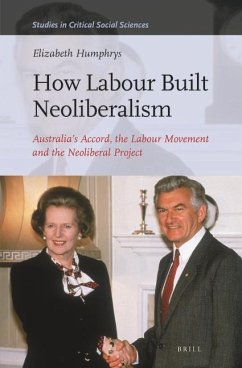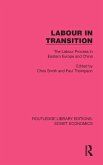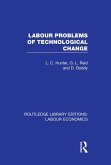Elizabeth Humphrys
How Labour Built Neoliberalism
Australia's Accord, the Labour Movement and the Neoliberal Project
Schade – dieser Artikel ist leider ausverkauft. Sobald wir wissen, ob und wann der Artikel wieder verfügbar ist, informieren wir Sie an dieser Stelle.
Elizabeth Humphrys
How Labour Built Neoliberalism
Australia's Accord, the Labour Movement and the Neoliberal Project
- Gebundenes Buch
- Merkliste
- Auf die Merkliste
- Bewerten Bewerten
- Teilen
- Produkt teilen
- Produkterinnerung
- Produkterinnerung
In How Labour Built Neoliberalism Elizabeth Humphrys examines the role of Labor Party and trade unions in constructing neoliberalism in Australia, and the implications of this for understanding neoliberalism's global advance.
Andere Kunden interessierten sich auch für
![Australian Politics and Government Australian Politics and Government]() Jeremy Moon / Campbell Sharman (eds.)Australian Politics and Government113,99 €
Jeremy Moon / Campbell Sharman (eds.)Australian Politics and Government113,99 €![New Zealand Rulers and Statesmen New Zealand Rulers and Statesmen]() William GisborneNew Zealand Rulers and Statesmen37,99 €
William GisborneNew Zealand Rulers and Statesmen37,99 €![Labour in Transition Labour in Transition]() Labour in Transition131,99 €
Labour in Transition131,99 €![Women in Industry Women in Industry]() Edith AbbottWomen in Industry42,99 €
Edith AbbottWomen in Industry42,99 €![Women in Industry Women in Industry]() Edith AbbottWomen in Industry41,99 €
Edith AbbottWomen in Industry41,99 €![Labour Problems of Technological Change Labour Problems of Technological Change]() L C HunterLabour Problems of Technological Change179,99 €
L C HunterLabour Problems of Technological Change179,99 €![Coolidge Coolidge]() Amity ShlaesCoolidge34,99 €
Amity ShlaesCoolidge34,99 €
In How Labour Built Neoliberalism Elizabeth Humphrys examines the role of Labor Party and trade unions in constructing neoliberalism in Australia, and the implications of this for understanding neoliberalism's global advance.
Produktdetails
- Produktdetails
- Verlag: Brill
- Seitenzahl: 280
- Erscheinungstermin: 11. Oktober 2018
- Englisch
- Abmessung: 241mm x 170mm x 23mm
- Gewicht: 590g
- ISBN-13: 9789004349001
- ISBN-10: 9004349006
- Artikelnr.: 53169674
- Herstellerkennzeichnung
- Libri GmbH
- Europaallee 1
- 36244 Bad Hersfeld
- gpsr@libri.de
- Verlag: Brill
- Seitenzahl: 280
- Erscheinungstermin: 11. Oktober 2018
- Englisch
- Abmessung: 241mm x 170mm x 23mm
- Gewicht: 590g
- ISBN-13: 9789004349001
- ISBN-10: 9004349006
- Artikelnr.: 53169674
- Herstellerkennzeichnung
- Libri GmbH
- Europaallee 1
- 36244 Bad Hersfeld
- gpsr@libri.de
Elizabeth Humphrys is a political economist at the University of Technology Sydney. She has published on trade union and social movement responses to crisis, including in Globalizations and Critical Sociology. She completed her Ph.D. (2016) at the University of Sydney.
Acknowledgements
List of Illustrations
List of Abbreviations
1 Introduction
1 The ALP & ACTU Accord
2 The Social Contract's Gala Dinner
3 Neoliberalism's Corporatist Origins
4 A Hegemonic Political Project
5 Corporatist &' involucro'
6 A Note on Method
7 Structure of the Book
2 Theorising the State-Civil Society Relationship
1 Introduction
1.1 Some Preliminary Comments
2 Marx's Critique of Hegel
3 From Critique of Politics to Critique of Political Economy
4 From Marx to Gramsci
4.1 Lo stato integrale
5 Gramsci contra Marx? The Limits of Integration
6 Conclusion
3 Corporatism in Australia
1 Introduction
2 Understanding Corporatism
3 Panitch's Approach
4 Corporatism and the Accord
5 The Context of Arbitration
6 Conclusion
4 Destabilising the Dominant Narrative
1 Introduction
1.1 Conceptual Diversity
2 The Dominant Narrative
2.1 Harvey: A Brief History of Neoliberalism
2.2 Klein: The Shock Doctrine
2.3 Peck, Theodore, Tickell and Brenner: &'Neoliberalisation'
2.4 Destabilising the Dominant Narrative
3 A Class Approach to Neoliberalism
3.1 Harvey: &'The restoration of class power'
3.2 Davidson: &'An entirely new political regime'
3.3 A Hegemonic Political Project
4 Conclusion
5 Periodising Neoliberalism
1 Introduction
2 Periodising Neoliberalism in Australia
3 Proto-neoliberal stage: 1973-1983
3.1 The Economic Crisis
3.2 The Whitlam Government
3.3 The Fraser Government
4 Vanguard Neoliberal Stage: 1983-1993
4.1 The Impasse of the 1970s
4.2 Developing the Accord
5 Piecemeal Neoliberalisation Stage: 1993-2008
5.1 Howard's Piecemeal Neoliberalism
6 Crisis stage: 2008 Onwards
7 Conclusion
6 The Disorganisation of Labour
1 Introduction
2 The Accord Agreement
3 Wages and the Accord
3.1 The First Accord (1983)
3.2 Accord Mark II (1985-1987)
3.3 Accord Mark III (1986-1987)
3.4 Accord Mark IV (1988-1989), V (1989-1990) & VI (1990-1993)
3.5 Accord Mark VII (1993) & VIII (Draft Only)
4 Wage Suppression
4.1 Labour Disorganisation
5 Conclusion
7 An Integral State
1 Introduction
2 Accord Divergences
2.1 The National Economic Summit and Communiqué
2.2 Prices
2.3 &'Big bang' and Other Neoliberal Reforms
2.4 Trade Liberalisation
3 Privatisation
4 Social Wage and Contested Understandings
4.1 Medicare
4.2 Superannuation
4.3 Worth the Cost?
5 The Concord of Neoliberalism and the Accord
5.1 A Brace against Neoliberalism?
5.2 Theorising the Corporatism-Neoliberalism Connection
5.3 An &'informal Accord'?
5.4 The Accord as involucro
6 Conclusion
8 How Labour Made Neoliberalism
1 Introduction
2 From Worker Agency to State Agency
2.1 The Shift to Support the Accord
2.2 Planning as a Solution to Crisis?
2.3 Consultation on, and Support for, the Accord
2.4 Sticking with the Accord
2.5 Industry policy and Australia Reconstructed
3 Managing Dissent and Disorganising Labour
3.1 Civil Legal Action against Labour Disputes
3.2 Deregistration of the Builders Labourers' Federation
3.3 Pilots' Dispute
4 Enterprise Bargaining and the Antinomies of the Accord
4.1 Hegemony Unravelling
5 Conclusion
9 A Return to the International
1 Introduction
2 A Brief Detour in the Antipodes
3 The British Social Contract (1974-1979)
4 The Carter Administration (1977-1981) and Prior
5 New York City Council Fiscal Crisis (1975-1981)
6 Contemporary Finland
7 Conclusion
10 Conclusion: Neoliberalism at Dusk
1 Internal Relations
2 Antinomies and Residues
3 Neoliberalism at Dusk
Appendices
Appendix B: Timeline of Predecessors to the AMWU
References
Index
List of Illustrations
List of Abbreviations
1 Introduction
1 The ALP & ACTU Accord
2 The Social Contract's Gala Dinner
3 Neoliberalism's Corporatist Origins
4 A Hegemonic Political Project
5 Corporatist &' involucro'
6 A Note on Method
7 Structure of the Book
2 Theorising the State-Civil Society Relationship
1 Introduction
1.1 Some Preliminary Comments
2 Marx's Critique of Hegel
3 From Critique of Politics to Critique of Political Economy
4 From Marx to Gramsci
4.1 Lo stato integrale
5 Gramsci contra Marx? The Limits of Integration
6 Conclusion
3 Corporatism in Australia
1 Introduction
2 Understanding Corporatism
3 Panitch's Approach
4 Corporatism and the Accord
5 The Context of Arbitration
6 Conclusion
4 Destabilising the Dominant Narrative
1 Introduction
1.1 Conceptual Diversity
2 The Dominant Narrative
2.1 Harvey: A Brief History of Neoliberalism
2.2 Klein: The Shock Doctrine
2.3 Peck, Theodore, Tickell and Brenner: &'Neoliberalisation'
2.4 Destabilising the Dominant Narrative
3 A Class Approach to Neoliberalism
3.1 Harvey: &'The restoration of class power'
3.2 Davidson: &'An entirely new political regime'
3.3 A Hegemonic Political Project
4 Conclusion
5 Periodising Neoliberalism
1 Introduction
2 Periodising Neoliberalism in Australia
3 Proto-neoliberal stage: 1973-1983
3.1 The Economic Crisis
3.2 The Whitlam Government
3.3 The Fraser Government
4 Vanguard Neoliberal Stage: 1983-1993
4.1 The Impasse of the 1970s
4.2 Developing the Accord
5 Piecemeal Neoliberalisation Stage: 1993-2008
5.1 Howard's Piecemeal Neoliberalism
6 Crisis stage: 2008 Onwards
7 Conclusion
6 The Disorganisation of Labour
1 Introduction
2 The Accord Agreement
3 Wages and the Accord
3.1 The First Accord (1983)
3.2 Accord Mark II (1985-1987)
3.3 Accord Mark III (1986-1987)
3.4 Accord Mark IV (1988-1989), V (1989-1990) & VI (1990-1993)
3.5 Accord Mark VII (1993) & VIII (Draft Only)
4 Wage Suppression
4.1 Labour Disorganisation
5 Conclusion
7 An Integral State
1 Introduction
2 Accord Divergences
2.1 The National Economic Summit and Communiqué
2.2 Prices
2.3 &'Big bang' and Other Neoliberal Reforms
2.4 Trade Liberalisation
3 Privatisation
4 Social Wage and Contested Understandings
4.1 Medicare
4.2 Superannuation
4.3 Worth the Cost?
5 The Concord of Neoliberalism and the Accord
5.1 A Brace against Neoliberalism?
5.2 Theorising the Corporatism-Neoliberalism Connection
5.3 An &'informal Accord'?
5.4 The Accord as involucro
6 Conclusion
8 How Labour Made Neoliberalism
1 Introduction
2 From Worker Agency to State Agency
2.1 The Shift to Support the Accord
2.2 Planning as a Solution to Crisis?
2.3 Consultation on, and Support for, the Accord
2.4 Sticking with the Accord
2.5 Industry policy and Australia Reconstructed
3 Managing Dissent and Disorganising Labour
3.1 Civil Legal Action against Labour Disputes
3.2 Deregistration of the Builders Labourers' Federation
3.3 Pilots' Dispute
4 Enterprise Bargaining and the Antinomies of the Accord
4.1 Hegemony Unravelling
5 Conclusion
9 A Return to the International
1 Introduction
2 A Brief Detour in the Antipodes
3 The British Social Contract (1974-1979)
4 The Carter Administration (1977-1981) and Prior
5 New York City Council Fiscal Crisis (1975-1981)
6 Contemporary Finland
7 Conclusion
10 Conclusion: Neoliberalism at Dusk
1 Internal Relations
2 Antinomies and Residues
3 Neoliberalism at Dusk
Appendices
Appendix B: Timeline of Predecessors to the AMWU
References
Index
Acknowledgements
List of Illustrations
List of Abbreviations
1 Introduction
1 The ALP & ACTU Accord
2 The Social Contract's Gala Dinner
3 Neoliberalism's Corporatist Origins
4 A Hegemonic Political Project
5 Corporatist &' involucro'
6 A Note on Method
7 Structure of the Book
2 Theorising the State-Civil Society Relationship
1 Introduction
1.1 Some Preliminary Comments
2 Marx's Critique of Hegel
3 From Critique of Politics to Critique of Political Economy
4 From Marx to Gramsci
4.1 Lo stato integrale
5 Gramsci contra Marx? The Limits of Integration
6 Conclusion
3 Corporatism in Australia
1 Introduction
2 Understanding Corporatism
3 Panitch's Approach
4 Corporatism and the Accord
5 The Context of Arbitration
6 Conclusion
4 Destabilising the Dominant Narrative
1 Introduction
1.1 Conceptual Diversity
2 The Dominant Narrative
2.1 Harvey: A Brief History of Neoliberalism
2.2 Klein: The Shock Doctrine
2.3 Peck, Theodore, Tickell and Brenner: &'Neoliberalisation'
2.4 Destabilising the Dominant Narrative
3 A Class Approach to Neoliberalism
3.1 Harvey: &'The restoration of class power'
3.2 Davidson: &'An entirely new political regime'
3.3 A Hegemonic Political Project
4 Conclusion
5 Periodising Neoliberalism
1 Introduction
2 Periodising Neoliberalism in Australia
3 Proto-neoliberal stage: 1973-1983
3.1 The Economic Crisis
3.2 The Whitlam Government
3.3 The Fraser Government
4 Vanguard Neoliberal Stage: 1983-1993
4.1 The Impasse of the 1970s
4.2 Developing the Accord
5 Piecemeal Neoliberalisation Stage: 1993-2008
5.1 Howard's Piecemeal Neoliberalism
6 Crisis stage: 2008 Onwards
7 Conclusion
6 The Disorganisation of Labour
1 Introduction
2 The Accord Agreement
3 Wages and the Accord
3.1 The First Accord (1983)
3.2 Accord Mark II (1985-1987)
3.3 Accord Mark III (1986-1987)
3.4 Accord Mark IV (1988-1989), V (1989-1990) & VI (1990-1993)
3.5 Accord Mark VII (1993) & VIII (Draft Only)
4 Wage Suppression
4.1 Labour Disorganisation
5 Conclusion
7 An Integral State
1 Introduction
2 Accord Divergences
2.1 The National Economic Summit and Communiqué
2.2 Prices
2.3 &'Big bang' and Other Neoliberal Reforms
2.4 Trade Liberalisation
3 Privatisation
4 Social Wage and Contested Understandings
4.1 Medicare
4.2 Superannuation
4.3 Worth the Cost?
5 The Concord of Neoliberalism and the Accord
5.1 A Brace against Neoliberalism?
5.2 Theorising the Corporatism-Neoliberalism Connection
5.3 An &'informal Accord'?
5.4 The Accord as involucro
6 Conclusion
8 How Labour Made Neoliberalism
1 Introduction
2 From Worker Agency to State Agency
2.1 The Shift to Support the Accord
2.2 Planning as a Solution to Crisis?
2.3 Consultation on, and Support for, the Accord
2.4 Sticking with the Accord
2.5 Industry policy and Australia Reconstructed
3 Managing Dissent and Disorganising Labour
3.1 Civil Legal Action against Labour Disputes
3.2 Deregistration of the Builders Labourers' Federation
3.3 Pilots' Dispute
4 Enterprise Bargaining and the Antinomies of the Accord
4.1 Hegemony Unravelling
5 Conclusion
9 A Return to the International
1 Introduction
2 A Brief Detour in the Antipodes
3 The British Social Contract (1974-1979)
4 The Carter Administration (1977-1981) and Prior
5 New York City Council Fiscal Crisis (1975-1981)
6 Contemporary Finland
7 Conclusion
10 Conclusion: Neoliberalism at Dusk
1 Internal Relations
2 Antinomies and Residues
3 Neoliberalism at Dusk
Appendices
Appendix B: Timeline of Predecessors to the AMWU
References
Index
List of Illustrations
List of Abbreviations
1 Introduction
1 The ALP & ACTU Accord
2 The Social Contract's Gala Dinner
3 Neoliberalism's Corporatist Origins
4 A Hegemonic Political Project
5 Corporatist &' involucro'
6 A Note on Method
7 Structure of the Book
2 Theorising the State-Civil Society Relationship
1 Introduction
1.1 Some Preliminary Comments
2 Marx's Critique of Hegel
3 From Critique of Politics to Critique of Political Economy
4 From Marx to Gramsci
4.1 Lo stato integrale
5 Gramsci contra Marx? The Limits of Integration
6 Conclusion
3 Corporatism in Australia
1 Introduction
2 Understanding Corporatism
3 Panitch's Approach
4 Corporatism and the Accord
5 The Context of Arbitration
6 Conclusion
4 Destabilising the Dominant Narrative
1 Introduction
1.1 Conceptual Diversity
2 The Dominant Narrative
2.1 Harvey: A Brief History of Neoliberalism
2.2 Klein: The Shock Doctrine
2.3 Peck, Theodore, Tickell and Brenner: &'Neoliberalisation'
2.4 Destabilising the Dominant Narrative
3 A Class Approach to Neoliberalism
3.1 Harvey: &'The restoration of class power'
3.2 Davidson: &'An entirely new political regime'
3.3 A Hegemonic Political Project
4 Conclusion
5 Periodising Neoliberalism
1 Introduction
2 Periodising Neoliberalism in Australia
3 Proto-neoliberal stage: 1973-1983
3.1 The Economic Crisis
3.2 The Whitlam Government
3.3 The Fraser Government
4 Vanguard Neoliberal Stage: 1983-1993
4.1 The Impasse of the 1970s
4.2 Developing the Accord
5 Piecemeal Neoliberalisation Stage: 1993-2008
5.1 Howard's Piecemeal Neoliberalism
6 Crisis stage: 2008 Onwards
7 Conclusion
6 The Disorganisation of Labour
1 Introduction
2 The Accord Agreement
3 Wages and the Accord
3.1 The First Accord (1983)
3.2 Accord Mark II (1985-1987)
3.3 Accord Mark III (1986-1987)
3.4 Accord Mark IV (1988-1989), V (1989-1990) & VI (1990-1993)
3.5 Accord Mark VII (1993) & VIII (Draft Only)
4 Wage Suppression
4.1 Labour Disorganisation
5 Conclusion
7 An Integral State
1 Introduction
2 Accord Divergences
2.1 The National Economic Summit and Communiqué
2.2 Prices
2.3 &'Big bang' and Other Neoliberal Reforms
2.4 Trade Liberalisation
3 Privatisation
4 Social Wage and Contested Understandings
4.1 Medicare
4.2 Superannuation
4.3 Worth the Cost?
5 The Concord of Neoliberalism and the Accord
5.1 A Brace against Neoliberalism?
5.2 Theorising the Corporatism-Neoliberalism Connection
5.3 An &'informal Accord'?
5.4 The Accord as involucro
6 Conclusion
8 How Labour Made Neoliberalism
1 Introduction
2 From Worker Agency to State Agency
2.1 The Shift to Support the Accord
2.2 Planning as a Solution to Crisis?
2.3 Consultation on, and Support for, the Accord
2.4 Sticking with the Accord
2.5 Industry policy and Australia Reconstructed
3 Managing Dissent and Disorganising Labour
3.1 Civil Legal Action against Labour Disputes
3.2 Deregistration of the Builders Labourers' Federation
3.3 Pilots' Dispute
4 Enterprise Bargaining and the Antinomies of the Accord
4.1 Hegemony Unravelling
5 Conclusion
9 A Return to the International
1 Introduction
2 A Brief Detour in the Antipodes
3 The British Social Contract (1974-1979)
4 The Carter Administration (1977-1981) and Prior
5 New York City Council Fiscal Crisis (1975-1981)
6 Contemporary Finland
7 Conclusion
10 Conclusion: Neoliberalism at Dusk
1 Internal Relations
2 Antinomies and Residues
3 Neoliberalism at Dusk
Appendices
Appendix B: Timeline of Predecessors to the AMWU
References
Index








